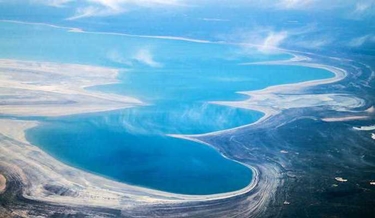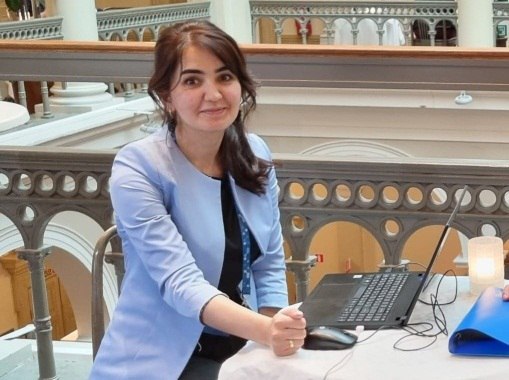Within the framework of the Aral Sea Basin Program-4 (ASPB-4), the flagship project of the International Fund for Saving the Aral Sea, 25 major projects totaling $591.3 million are in the process of implementation. This was stated by the chief specialist of the IFAS Department of International Relations Dilorom Sheralieva in an interview with the National News Agency of Tajikistan “Khovar”.
All these projects are designed to contribute to the environmental sustainability of the region and improve the socio-economic living conditions of almost 60 million people of the Aral Basin.
The full text of the interview can be found here: http://khovar.tj/2023/09/fondi-bajnalmilalii-na-oti-aral-1alli-mushkiloti-vobasta-ba-in-ba-r-ba-manfiati-60-million-a-olii-ududi-osiyoi-markaz-o-ad-bud/
In addition, regional joint projects with international development partners are being implemented. Their total budget is US $ 47.4 million.
According to Sheralieva, national projects with a total cost of US $ 543.9 million are being realized on the territory of the founding states of the International Fund for Saving the Aral Sea.
With the support of the World Bank, the Executive Committee of the International Fund for Saving the Aral Sea (IFAS) created a platform to coordinate activities between the governments of IFAS founding states and development partners for the joint implementation of projects and programs in Central Asia, including the ASBP-4 project.
Additionally, the German Society for International Cooperation (GIZ) is supporting the implementation of the “Regional Climate Change Adaptation Strategy” with a budget of 8 million Euros and the “Climate Risk Management” project worth 10 million Euros for the period 2022-2026, both within the framework of the ASBP-4 and the Green Central Asia initiative.
The origins of the Aral crisis
In the 60s of the 20th century, the Aral Sea was one of the largest reservoirs and was one of the great lakes of the world. As of 2020, 60 million people – about 80.7% of the region’s population – live in the Aral Sea basin, which makes up 60% of the territory of Central Asia.
The Aral Sea was once a thriving ecosystem, supporting shipping, tourism, and fishing. Photographic evidence of the diversity of fauna and flora in the Aral Sea and its basin still exists.
Half of all biological species existing within the borders of the former Soviet Union populated the Aral Sea basin.
From 1960 to 1990, the area of irrigated land in Central Asia increased from 4.5 million to 7 million hectares, mainly causing water depletion in the Aral Sea. In 1989, the sea was divided into two reservoirs: the Northern (Small) and the Southern (Large) Aral Sea.
Changes in the water balance of rivers, as well as an increase in the mineralization of water in the Aral Sea, led to the disappearance of rare biocenoses and several endemic animal species. Also, the decrease in the water flow in the Aral Sea led to an irreversible change in the hydrological and hydrochemical regime of the sea and its ecosystems. The change in the salt balance turned the reservoir into a biological desert.
Taking into account the situation and with the aim to address the ecological crisis and improve the socio-economic situation of the Aral Sea basin, recognized by the world community as one of the largest disasters of the twentieth century, in 1993 the heads of Central Asian States (Turkmenistan, Kazakhstan, Kyrgyzstan, Uzbekistan, Tajikistan) established the International Fund for Saving the Aral Sea.
What measures has the International Fund for Saving the Aral Sea taken as a responsible organization to overcome the Aral crisis?
One of the measures taken within the framework of IFAS activities to mitigate the consequences of the Aral Sea crisis and eliminate its economic, social and environmental problems is the adoption of several Aral Sea Basin Programs (ASBP). These programs are designed to improve the living standards and well-being of the 60 million people in the Aral Sea basin, and to address the ecological and socio-economic challenges facing the region.
Several regional and national projects aimed at improving water resources management, enhancing water supply, sanitation and health care, increasing irrigation productivity and efficiency, strengthening the capacity of hydrometeorological services and improving environmental sustainability in general were implemented within the framework of the ASBP.
During the period of Tajikistan’s chairmanship in IFAS on 29 June 2021, the Aral Sea Basin Program-4 (ASPB-4) was approved and is currently in operation.
ASPB-4 consists of four directions and includes 34 national and regional projects. These includes:
1) Integrated use of water resources is the first direction carried out on the basis of the introduction of advanced technologies to ensure the efficiency of water use and reduce losses at all levels – from the river basin to water users.
2) The ecological direction is aimed at protecting the environment and is carried out in order to ensure the environmental sustainability of aquatic and surface ecosystems.
3) The socio-economic direction is aimed at implementing regional projects on water supply and access to water for sustainable development of the countries of the Aral Sea basin, as well as ensuring the implementation of the SDG 6 “Ensure access to water and sanitation for all”.
4) Improvement of the organizational structure and legal framework is the fourth direction of the ASPB-4 and is aimed at the development and implementation of regional projects to improve policy mechanisms and legal framework. ///nCa, 5 September 2023
#Aralsea, #IFAS, #International_Fund_for_Saving_the_Aral_Sea, #Tajikistan, #Turkmenistan, #Kazakhstan, #Kyrgyzstan, #Uzbekistan, #CentralAsia

